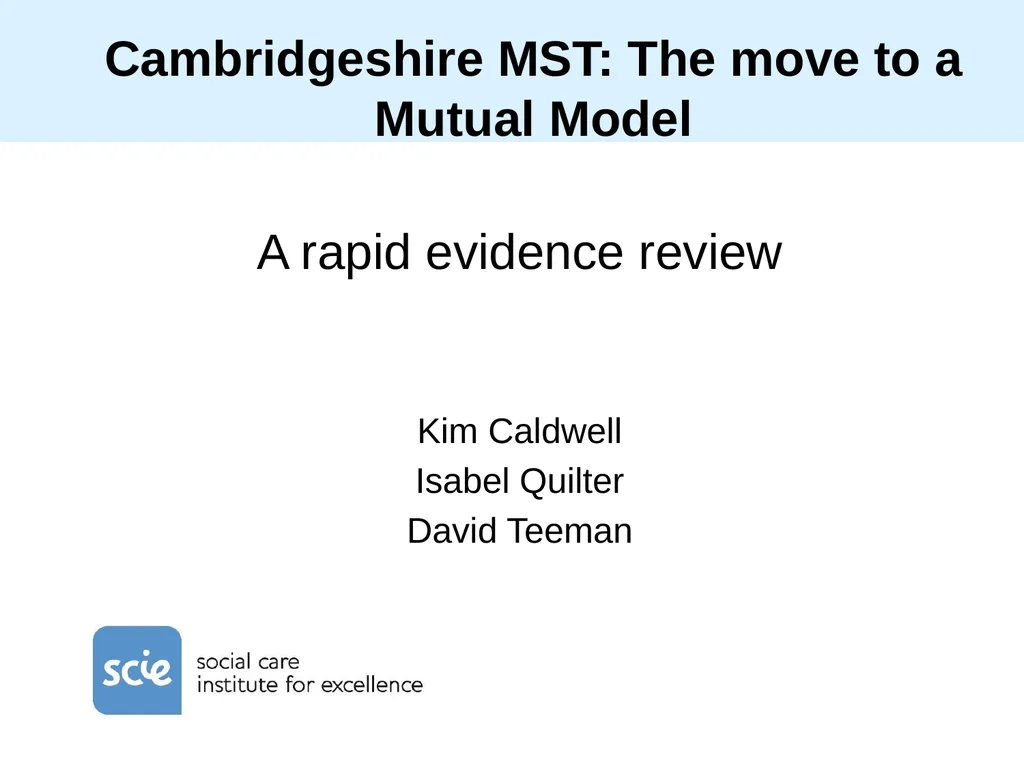Cambridgeshire MST: The move to a Mutual Model A
Author : pasty-toler | Published Date : 2025-05-29
Description: Cambridgeshire MST The move to a Mutual Model A rapid evidence review Kim Caldwell Isabel Quilter David Teeman Format of review Key statsbackground Aims and objectives Review questions Methods What this review is not Addressing the key
Presentation Embed Code
Download Presentation
Download
Presentation The PPT/PDF document
"Cambridgeshire MST: The move to a Mutual Model A" is the property of its rightful owner.
Permission is granted to download and print the materials on this website for personal, non-commercial use only,
and to display it on your personal computer provided you do not modify the materials and that you retain all
copyright notices contained in the materials. By downloading content from our website, you accept the terms of
this agreement.
Transcript:Cambridgeshire MST: The move to a Mutual Model A:
Cambridgeshire MST: The move to a Mutual Model A rapid evidence review Kim Caldwell Isabel Quilter David Teeman Format of review Key stats/background Aims and objectives Review questions Methods What this review is not Addressing the key review questions ‘So what?’/Implications of the evidence Key stats In the year to March 2014, over 30,400 children started to be looked after by local authorities in England, and the number of new entrants to care is increasing Of these children, 28% were aged 10-15 The majority of these children became looked after on s.20 placements due to their own disruptive behaviour/other relevant CIN categories Outcomes for children in care are notoriously poor: 15.3% of LAC achieved 5 A*-C GCSEs in 2013 compared to 58% overall, 40% of prisoners under 21 were in care as children, and children in care are 4-5 times more likely to have mental health issues than their peers The cost to the public purse of looking after a child is estimated to be around £36,524 Cambridgeshire MST: towards a mutual mode of delivery In 2001, Cambridgeshire County Council implemented the first MST team in Great Britain, with the aim of preventing adolescents from entering custody and then expanded to those at risk of entry to care A local research sample of 57 cases eligible for MST between January 2009 and November 2010 demonstrated significant improvement in outcomes in both the number of days in care and the continued involvement in services between the MST and non-MST groups at 12 month follow up Since 2013, Cambridgeshire County Council has been considering the possibility of spinning out the MST service to allow for freer expansion After a thorough assessment process, it has become apparent that a public service mutual is the most sensible option This new independent organisation will both provide both clinical service delivery and consultancy services to support effective implementation across a broader geography Why a mutual mode of delivery? There is increasing interest in using mutuals to deliver public services. This is due to:- The Government’s commitment to creating a ‘Big Society’ through introducing a greater diversity of public service providers, and; a view held by many authorities that mutuals could be a possible way to sustain local public services during a period of unprecedented public spending cuts (Proof of Delivery? A review of the role of co-operatives and mutual in local service Provision) Aims and objectives














